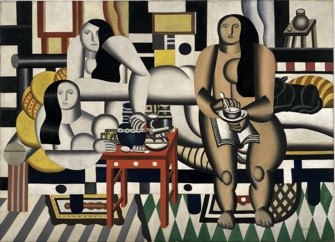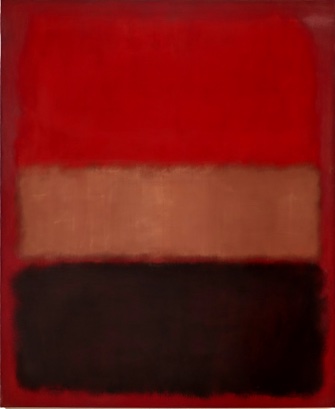New Slant on
Modern Art

“Three Women (Le Grand Déjeuner)” (1921), by Fernand Léger. © Adagp, Paris 2015. Photo © 2015 Digital Image, the Museum of Modern Art, New York/Scala, Florence
The current exhibition at the Fondation Louis Vuitton, “Les Clefs d’une Passion” (“Keys to a Passion”), offers a concise, beautifully presented overview of art from the first half of the 20th century.
Rather than approaching the subject chronologically, the show breaks down the art into four categories: “Subjective Expressionism,” “Contemplative,” “Popist” and “Music.”
The “Subjective Expressionism” section is full of moody works, including two gray monochrome paintings by Giacometti, and more troubling ones like Francis Bacon’s “Study from the Human Body” (1949) and “Study for Portrait” (1949). Neither of the latter two paintings feature the twisted, tortured bodies we have come to expect from Bacon, but both, painted mostly in grim shades of gray and ocher, express feelings of anxiety – in the first, a naked man, back to the viewer, walks through a curtain – or horror – in the second, a screaming man in a suit, imprisoned in a cage, his mouth a black hole, seems to be threatened by the mysterious bright-blue shadow at the bottom of the image.
Speaking of screaming, the second room of this section features Edvard Munch’s overhyped “The Scream,” lent by the Munch Museum in Oslo. Much more interesting is the series of five self-portraits by Finnish painter Helene Schjerfbeck (1862-1946), in which we see the artist aging from youthful vitality in 1915 to depleted old age in 1944.
After those anxiety-inducing images, it’s a relief, then, to enter the “Contemplative” section. The first room is filled with colorful, tranquil nature scenes by Finnish painter Akseli Gallen-Kallela, Ferdinand Hodler, Emil Nolde and Piet Mondrian (painted before he turned to grid-based abstractions). It was the next room, however, that had an immediate and powerful calming effect on me, with a collection of small abstract paintings, mostly in black and white, by Malevitch and Mondrian. The striking exception is a large, predominantly red painting by Mark Rothko, which offers a nice counterpart to its quiet

“No. 46 [Black, Ochre, Red Over Red]” (1957), by Mark Rothko. © 1998 Kate Rothko Prizel & Christopher Rothko. ADAGP, Paris, 2015. Photo: The Museum of Contemporary Art, Los Angeles
neighbors while also managing to exert a soothing influence.
I didn’t know what the curators meant by “Popist” until I saw the next room, with a series of borderline-kitsch paintings by Francis Picabia, a large painting by Robert Delaunay and three by Fernard Léger, all of which take inspiration from popular culture, hence “Popist,” apparently meaning “forerunners to Pop Art.”
The final room, “Music,” dominated by Matisse’s “La Danse” (1909-10), lent by the State Hermitage Museum in St. Petersburg, also presents a wonderful large-scale paper cutout the artist made near the end of his life, “The Sorrows of the King” (1952), a semi-abstract piece depicting an aging musician-king, a dancer and a tambourine player. Also in the room is a 1914 series of four abstract paintings – fantastic explosions of color and form – by Wassily Kandinsky, the father of abstraction, and a complex work by Italian Futurist Gino Severini, “Dynamic Hieroglyph of the Bal Tabarin” (1912), a dazzling, fragmented dissection of a Parisian dance hall.
The curators have done a marvelous job of stimulating new ways of thinking about modern art and have hung the works so that they segue beautifully from one to the next: the colors in a seascape by Hodler, for example, echo the blues and greens in a Monet water lily painting next to it. It is also refreshing and unexpected to find not just the crowd-pleasing names of modern art – those whose works are fought over by billionaires and trillionaires at auction and fetch ridiculously extravagant prices – but also many lesser-known artists and atypical works by celebrated artists like Bacon and Mondrian. Bravo!
Fondation Louis Vuitton: 8, avenue du Mahatma Gandhi, Bois de Boulogne, 75116 Paris. Métro: Les Sablons. Tel.: 01 40 69 96 00. Open Monday, Wednesday-Sunday, 11am-8pm, until 11pm on Friday. Closed Tuesday, Christmas Day and New Year’s Day. Admission: €14. Through July 6. www.fondationlouisvuitton.fr
Reader reaction: Click here to respond to this article (your response may be published on this page and is subject to editing).
Please support Paris Update by ordering books from Paris Update’s Amazon store at no extra cost. Click on your preferred Amazon location: U.K., France, U.S.
More reviews of Paris art shows.
© 2015 Paris Update
Favorite